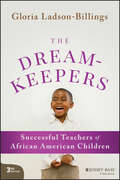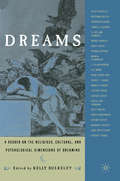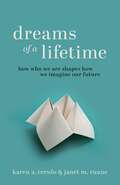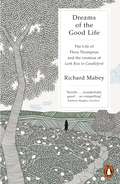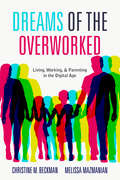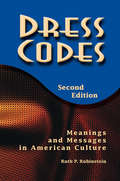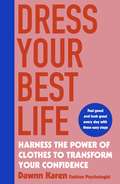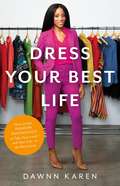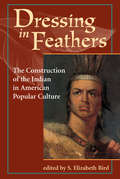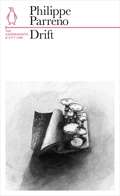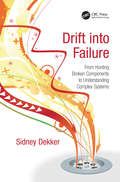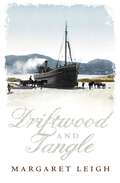- Table View
- List View
The Dreamkeepers: Successful Teachers of African American Children
by Gloria Ladson-BillingsDiscover how to give African American children the education they deserve with this updated new resource In the newly revised Third Edition of The Dreamkeepers: Successful Teachers of African American Children, distinguished professor Dr. Gloria Ladson-Billings delivers an encouraging exploration of the future of education for African American students. She describes eight exemplary teachers, all of whom differ in their personal style and methods, who share an approach to teaching that affirms and strengthens cultural identity. In this mixture of scholarship and storytelling, you’ll learn how to create intellectually rigorous and culturally relevant classrooms that have the power to improve the lives of all children. This important book teaches: What successful teachers do, don’t do, and what we can learn from them Why it’s so important for teachers to work with the unique strengths each student brings to the classroom How to improve educational outcomes for African American children across the country Perfect for teachers, parents, school leaders, and administrators, The Dreamkeepers will also earn a place in the libraries of school boards, professors of education, urban sociologists, and casual readers with an interest in issues of race and education.
Dreams: A Reader on Religious, Cultural and Psychological Dimensions of Dreaming
by K. BulkeleyThe recent centennial of the original publication of Sigmund Freud's The Interpretation of Dreams has generated a new wave of critical reappraisals of this monumental work. Considered one of the most important books in Western history, scholars from an astonishing variety of academic fields continue to wrestle with Freud's intricate theories and insights. Dreams is a long overdue collection of writing on dreams from many of the top scholars in religious studies, anthropology, and psychology departments. The volume is organized into three thematic sections: traditions, individuals and methods. The twenty-three articles highlight the most important theories, the most contentious debates, and the most far-reaching implications of this growing field of study.
Dreams of a Lifetime: How Who We Are Shapes How We Imagine Our Future
by Karen A. Cerulo Janet M. RuaneHow social status shapes our dreams of the future and inhibits the lives we envision for ourselvesMost of us understand that a person’s place in society can close doors to opportunity, but anything is possible when we dream about what might be, or so we think. Dreams of a Lifetime reveals that what and how we dream—and whether we believe our dreams can actually come true—are tied to our social class, gender, race, age, and life events.Karen Cerulo and Janet Ruane argue that our social location shapes the seemingly private and unique life of our minds. We are all free to dream about possibilities, but not all dreamers are equal. Cerulo and Ruane show how our social position ingrains itself on our mind’s eye, quietly influencing the nature of our dreams, whether we embrace dreaming or dream at all, and whether we believe that our dreams, from the attainable to the improbable, can become realities. They explore how inequalities stemming from social disadvantages pattern our dreams for ourselves, and how sociocultural disparities in how we dream exacerbate social inequalities and limit the life paths we believe are open to us.Drawing on a wealth of original interviews with people from diverse social backgrounds, Dreams of a Lifetime demonstrates how the study of our dreams can provide new avenues for understanding and combatting inequality—including inequalities that precede action or outcome.
Dreams of a Lifetime: How Who We Are Shapes How We Imagine Our Future
by Karen A. Cerulo Janet M. RuaneHow social status shapes our dreams of the future and inhibits the lives we envision for ourselvesMost of us understand that a person’s place in society can close doors to opportunity, but anything is possible when we dream about what might be, or so we think. Dreams of a Lifetime reveals that what and how we dream—and whether we believe our dreams can actually come true—are tied to our social class, gender, race, age, and life events.Karen Cerulo and Janet Ruane argue that our social location shapes the seemingly private and unique life of our minds. We are all free to dream about possibilities, but not all dreamers are equal. Cerulo and Ruane show how our social position ingrains itself on our mind’s eye, quietly influencing the nature of our dreams, whether we embrace dreaming or dream at all, and whether we believe that our dreams, from the attainable to the improbable, can become realities. They explore how inequalities stemming from social disadvantages pattern our dreams for ourselves, and how sociocultural disparities in how we dream exacerbate social inequalities and limit the life paths we believe are open to us.Drawing on a wealth of original interviews with people from diverse social backgrounds, Dreams of a Lifetime demonstrates how the study of our dreams can provide new avenues for understanding and combatting inequality—including inequalities that precede action or outcome.
Dreams of the Good Life: The Life of Flora Thompson and the Creation of Lark Rise to Candleford
by Richard MabeyWhile the Lark Rise to Candleford trilogy, Flora Thompson's much-loved portrait of life in the English countryside, has inspired a hit television series, relatively little is known about the author herself. In this highly original book, bestselling biographer and nature writer Richard Mabey sympathetically retraces her life and her transformation from a post-office clerk who left school at fourteen to a sophisticated professional writer. Revealing how a formidable imagination can arise from the humblest of beginnings, Dreams of the Good Life paints a poignant, unforgettable portrait of a working-class woman writer's struggle for creative expression.
Dreams of the Overworked: Living, Working, and Parenting in the Digital Age
by Christine M. Beckman Melissa MazmanianA riveting look at the real reasons Americans feel inadequate in the face of their dreams, and a call to celebrate how we support one another in the service of family and work in our daily life. Jay's days are filled with back-to-back meetings, but he always leaves work in time to pick his daughter up from swimming at 7pm, knowing he'll be back on his laptop later that night. Linda thinks wistfully of the treadmill in her garage as she finishes folding the laundry that's been in the dryer for the last week. Rebecca sits with one child in front of a packet of math homework, while three others clamor for her attention. In Dreams of the Overworked, Christine M. Beckman and Melissa Mazmanian offer vivid sketches of daily life for nine families, capturing what it means to live, work, and parent in a world of impossible expectations, now amplified unlike ever before by smart devices. We are invited into homes and offices, where we recognize the crushing pressure of unraveling plans, and the healing warmth of being together. Moreover, we witness the constant planning that goes into a "good" day, often with the aid of phones and apps. Yet, as technologies empower us to do more, they also promise limitless availability and connection. Checking email on the weekend, monitoring screen time, and counting steps are all part of the daily routine. The stories in this book challenge the seductive myth of the phone-clad individual, by showing that beneath the plastic veneer of technology is a complex, hidden system of support—our dreams being scaffolded by retired in-laws, friendly neighbors, spouses, and paid help. This book makes a compelling case for celebrating the structures that allow us to strive for our dreams, by supporting public policies and community organizations, challenging workplace norms, reimagining family, and valuing the joy of human connection.
Dreamscapes of Modernity: Sociotechnical Imaginaries and the Fabrication of Power
by Sheila Jasanoff Sang-Hyun KimDreamscapes of Modernity offers the first book-length treatment of sociotechnical imaginaries, a concept originated by Sheila Jasanoff and developed in close collaboration with Sang-Hyun Kim to describe how visions of scientific and technological progress carry with them implicit ideas about public purposes, collective futures, and the common good. The book presents a mix of case studies—including nuclear power in Austria, Chinese rice biotechnology, Korean stem cell research, the Indonesian Internet, US bioethics, global health, and more—to illustrate how the concept of sociotechnical imaginaries can lead to more sophisticated understandings of the national and transnational politics of science and technology. A theoretical introduction sets the stage for the contributors’ wide-ranging analyses, and a conclusion gathers and synthesizes their collective findings. The book marks a major theoretical advance for a concept that has been rapidly taken up across the social sciences and promises to become central to scholarship in science and technology studies.
Dreamscapes of Modernity: Sociotechnical Imaginaries and the Fabrication of Power
by Sheila Jasanoff Sang-Hyun KimDreamscapes of Modernity offers the first book-length treatment of sociotechnical imaginaries, a concept originated by Sheila Jasanoff and developed in close collaboration with Sang-Hyun Kim to describe how visions of scientific and technological progress carry with them implicit ideas about public purposes, collective futures, and the common good. The book presents a mix of case studies—including nuclear power in Austria, Chinese rice biotechnology, Korean stem cell research, the Indonesian Internet, US bioethics, global health, and more—to illustrate how the concept of sociotechnical imaginaries can lead to more sophisticated understandings of the national and transnational politics of science and technology. A theoretical introduction sets the stage for the contributors’ wide-ranging analyses, and a conclusion gathers and synthesizes their collective findings. The book marks a major theoretical advance for a concept that has been rapidly taken up across the social sciences and promises to become central to scholarship in science and technology studies.
Dreamscapes of Modernity: Sociotechnical Imaginaries and the Fabrication of Power
by Sheila Jasanoff Sang-Hyun KimDreamscapes of Modernity offers the first book-length treatment of sociotechnical imaginaries, a concept originated by Sheila Jasanoff and developed in close collaboration with Sang-Hyun Kim to describe how visions of scientific and technological progress carry with them implicit ideas about public purposes, collective futures, and the common good. The book presents a mix of case studies—including nuclear power in Austria, Chinese rice biotechnology, Korean stem cell research, the Indonesian Internet, US bioethics, global health, and more—to illustrate how the concept of sociotechnical imaginaries can lead to more sophisticated understandings of the national and transnational politics of science and technology. A theoretical introduction sets the stage for the contributors’ wide-ranging analyses, and a conclusion gathers and synthesizes their collective findings. The book marks a major theoretical advance for a concept that has been rapidly taken up across the social sciences and promises to become central to scholarship in science and technology studies.
Dreamscapes of Modernity: Sociotechnical Imaginaries and the Fabrication of Power
by Sheila Jasanoff and Sang-Hyun Kim Sang-Hyun KimDreamscapes of Modernity offers the first book-length treatment of sociotechnical imaginaries, a concept originated by Sheila Jasanoff and developed in close collaboration with Sang-Hyun Kim to describe how visions of scientific and technological progress carry with them implicit ideas about public purposes, collective futures, and the common good. The book presents a mix of case studies—including nuclear power in Austria, Chinese rice biotechnology, Korean stem cell research, the Indonesian Internet, US bioethics, global health, and more—to illustrate how the concept of sociotechnical imaginaries can lead to more sophisticated understandings of the national and transnational politics of science and technology. A theoretical introduction sets the stage for the contributors’ wide-ranging analyses, and a conclusion gathers and synthesizes their collective findings. The book marks a major theoretical advance for a concept that has been rapidly taken up across the social sciences and promises to become central to scholarship in science and technology studies.
Dreamscapes of Modernity: Sociotechnical Imaginaries and the Fabrication of Power
by Sheila Jasanoff and Sang-Hyun Kim Sang-Hyun KimDreamscapes of Modernity offers the first book-length treatment of sociotechnical imaginaries, a concept originated by Sheila Jasanoff and developed in close collaboration with Sang-Hyun Kim to describe how visions of scientific and technological progress carry with them implicit ideas about public purposes, collective futures, and the common good. The book presents a mix of case studies—including nuclear power in Austria, Chinese rice biotechnology, Korean stem cell research, the Indonesian Internet, US bioethics, global health, and more—to illustrate how the concept of sociotechnical imaginaries can lead to more sophisticated understandings of the national and transnational politics of science and technology. A theoretical introduction sets the stage for the contributors’ wide-ranging analyses, and a conclusion gathers and synthesizes their collective findings. The book marks a major theoretical advance for a concept that has been rapidly taken up across the social sciences and promises to become central to scholarship in science and technology studies.
Dreamscapes of Modernity: Sociotechnical Imaginaries and the Fabrication of Power
by Sheila Jasanoff and Sang-Hyun Kim Sang-Hyun KimDreamscapes of Modernity offers the first book-length treatment of sociotechnical imaginaries, a concept originated by Sheila Jasanoff and developed in close collaboration with Sang-Hyun Kim to describe how visions of scientific and technological progress carry with them implicit ideas about public purposes, collective futures, and the common good. The book presents a mix of case studies—including nuclear power in Austria, Chinese rice biotechnology, Korean stem cell research, the Indonesian Internet, US bioethics, global health, and more—to illustrate how the concept of sociotechnical imaginaries can lead to more sophisticated understandings of the national and transnational politics of science and technology. A theoretical introduction sets the stage for the contributors’ wide-ranging analyses, and a conclusion gathers and synthesizes their collective findings. The book marks a major theoretical advance for a concept that has been rapidly taken up across the social sciences and promises to become central to scholarship in science and technology studies.
Drehbücher des Alter: Die soziale Konstruktion von Modellen und Formen der Lebensführung und -stilisierung älterer Menschen (Alter(n) und Gesellschaft)
by Ludwig AmrheinIn dieser Arbeit wird der Versuch unternommen, methodische, theoretische und empirische Bausteine für eine angemessene Erforschung der Lebensführung und -stilisierung im Alter und über den Lebensverlauf hinweg zu liefern. Im ersten Teil wird der bisherige theoretische und empirische Forschungsstand systematisch rekonstruiert, woraus Schlussfolgerungen für theorien- und methodenintegrative Anschlussmöglichkeiten gezogen werden. In einem zweiten Teil werden die soziologischen und sozialgerontologischen Forschungspotenziale aufgegriffen und zu einem Modell der gesellschaftlichen Konstruktion der Lebensführung im Alter verdichtet. Der dritte Teil schließlich verdeutlicht anhand von ausgewählten Ergebnissen einer qualitativen Studie zur Lebensführung im Alter die empirische Anwendbarkeit der konzeptionellen Überlegungen. Die grundlegende These dieser Arbeit lautet, dass die alltägliche Lebensführung im Alter aus einer nutzenorientierten Selektion von sozial konstruierten und biographisch angeeigneten Deutungs- und Handlungsmodellen des Alter(n)s resultiert.
Drei Generationen im Gespräch – Eine Studie zum intergenerativen Zukunftsmanagement
by Thomas DruyenIm Rahmen der Vermögensforschung haben sich neben den Themen des Reichtums auch das Vermögen des Alters, der Generationen und der Gesundheit als wesentliche Perspektiven herausgestellt. Diese Potenziale sind zugleich wesentlich in der Gestaltung der aktuellen demografischen Veränderungsprozesse. Wissenschaftliche Erkenntnisse zur Dringlichkeit finanzieller, gesundheitlicher und biografischer Vorsorge liegen vor – sie finden jedoch bei den Betroffenen kaum handlungsleitenden Niederschlag. Die vorliegende Studie untersucht anhand intergenerativer Befragungen Perspektiven und Verdrängungsmechanismen in Bezug auf die Zukunftsgestaltung. Mit der gestiegenen Lebenserwartung hat sich die vor jedem liegende Zukunft signifikant verlängert. Umso größer sind die Optionen – und die Notwendigkeit – der vorsorgenden Einwirkung. Dieses Verständnis soll mit der vorliegenden Arbeit befördert werden.
Dresdens Glanz, Stolz der Dresdner: Lokale Kommunikation, Stadtkultur und städtische Identität (Sozialwissenschaft)
by Gabriela B. ChristmannGabriela B. Christmann rekonstruiert mittels einer Diskursanalyse die historische Herausentwicklung und die thematischen Kristallisationen der Dresdner Stadtkultur. Sie zeigt, dass innerhalb der verschiedenen Formen der Lokalkommunikation über die Jahrhunderte hinweg typische Topoi regelmäßig wiederkehren, die zu dem geführt haben, was die Identität der Stadt Dresden ausmacht.
Dress Codes: Meanings And Messages In American Culture
by Ruth RubinsteinRich with illustrations, this revised and updated second edition of Dress Codes systematically analyzes the meaning and relevance of clothing in American culture. Presented here is an up-to-date analysis of images of power and authority, gender, seduction (the sexy look, the alluring look, the glamorous look, the vulnerable look), wealth and beauty, youth and health, and leisure and political hierarchy. Taken together, the chapters offer to the student and the general reader a complete "semiotics of clothing" in a form that is highly readable, very entertaining, and thoroughly informative. The illustrations provide fascinating glimpses into the history of American fashion and clothing-along with their antecedents in Europe-as well as a fine collection of images from the more familiar world of contemporary America.Rubinstein has identified six distinct categories of dress in American society, upon which Dress Codes is based. "Clothing signs" were instituted by those in authority, have one meaning, indicate behavior, and are required attire (police uniforms, or the clothing of ministers and priests); ?clothing symbols," on the other hand, reflect the achievement of cultural values?wealth, beauty, you and health. The wearing of clothing symbols?designer clothing or jewelry?may have several meanings; '`'clothing tie-signs,? which are specific types of clothing that indicate membership in a community outside mainstream culture (Hasidic, Amish, or Hare Krishna attire). They were instituted by those in authority, have one meaning, they indicate expected behavior, and are required attire; clothing tie symbols emanate from hopes, fears, and dreams of particular groups. They include trendy styles such as hip-hop, hippie, and gothic. Another category, contemporary fashion, reflects consumer sentiments and the political and economic forces of the period. Personal dress, refers to the "I" component we bring in when dressing the public self (bowtie, dramatic, or artistic attire). Many of these images have their roots in the collective memory of western society. Written in a lively and entertaining style, Dress Codes will fascinate both general readers and students interested in the history of fashion and costume, fashion design, human development, and gender studies.
The Dress of Women: A Critical Introduction to the Symbolism and Sociology of Clothing (Contributions in Women's Studies)
by Charlotte Perkins GilmanOriginally serialized in 1915 in The Forerunner, and never before published in book form, The Dress of Women presents Gilman's feminist sociological analysis of clothing in modern society. Gilman explores the social and functional basis for clothing, excavates the symbolic role of women's clothing in patriarchal societies, and, among other things, explicates the aesthetic and economic principles of socially responsible clothing design. The introduction, by Hill and Deegan, situates The Dress of Women within Gilman's intellectual work as a sociologist, and relates her sociological ideas to the themes she developed in some of her other works.Although written in 1915, Gilman's treatment of clothing and dress remains relevant. This pioneering effort adds substantially to Gilman's reputation as a sociological theorist and feminist. In addition, it represents one of the earliest full-length specifically sociological analyses of clothing and the fashion industry. Ultimately, the author concludes that harmful and degrading aspects of women's dress are amenable to reform if men and women will work together rationally to change the controlling institutional patterns of the society in which they live. This groundbreaking work will appeal to those interested in Gilman, feminist theory, sociological theory, social psychology, women's literature, and women's studies.
Dress Your Best Life: Harness the Power of Clothes To Transform Your Confidence
by Dawnn KarenHow you dress matters. What you wear affects your mood, how you feel about yourself and how others think about you. As an Ivy League educated therapist, publicist, former model and fashion designer, Dawnn Karen is an authority on the use of clothing to express identity and boost mood. Karen has spent years studying the relationship between attire and attitude, and her clients range from high-powered executives and politicians, to new parents and people who have recently experienced a major life change or trauma. Drawing on her research and work with clients, Karen will teach you how to: · dress to enhance your mood · avoid the 'I have nothing to wear' feeling · take the stress out of getting ready · project confidence at work · repurpose the wardrobe you already have Packed with practical tips and cutting-edge advice, Dress Your Best Life will empower you to make the right clothing choices for you. The first and definitive guide to fashion psychology, this book will ensure you leave the house feeling calmer, happier and more confident.
Dress Your Best Life: How to Use Fashion Psychology to Take Your Look -- and Your Life -- to the Next Level
by Dawnn KarenHarness the power of your wardrobe to achieve your dreams with this timely take on personal style from a world-renowned fashion psychologist.You may get dressed every day without really thinking about what you're putting on, but did you know that what you wear has a powerful effect on how you feel? Or that your clothes influence the way others perceive you? By making a few adjustments to your wardrobe, and learning to style from the inside out, you'll not only elevate your look, but level up your entire life. Dawnn Karen is a pioneer in the field of fashion psychology, and she has spent years studying the relationship between attire and attitude. In Dress Your Best Life she goes far beyond well-known makeover advice, pushing you to ask yourself: Are my clothing choices hurting me or helping me to achieve my life goals? Her book will help you discover your unique style story, become a smarter shopper, use color to your advantage, match moods to clothing choices, and embrace new or different standards of beauty. This knowledge is a power that you'll exercise every time you open your closet door or walk into an important meeting in just the right outfit.Packed with practical tips and cutting-edge advice, Dress Your Best Life will teach you to harness the power of fashion for the life you want to live.
The Dressed Society: Clothing, the Body and Some Meanings of the World
by Dr Peter CorriganIt was traditionally said that 'clothes maketh the man'. But what codes and meanings are associated with dress in a society that consists of divisions between class, race, gender, family status and religion? Is social and cultural life still fundamentally themed by the clothes that we wear? If so, how should we read these codes and themes in order to decipher their relation to power and meaning? This exhaustive book demonstrates how dress shapes and is shaped by social processes and phenomena such as beauty, time, the body, the gift exchange, class, gender and religion. It does this through an analysis of topics like the Islamic clothing controversy in state schools, the multitude of identities associated with dress, the Dress Reform movement, the construction of the body in fashion magazines and the role of the internet in fashion. What emerges is a trenchant, sharply observed account of the place of dress in contemporary society. The book will be of interest to students and researchers in Sociology, Cultural Studies, Women's Studies, Gender Studies, Anthropology and Fashion Studies.
Dressing In Feathers: The Construction Of The Indian In American Popular Culture
by S. Elizabeth BirdOne hundred members of NatChat, an electronic mail discussion group concerned with Native American issues, responded to the recent Disney release Pocahontas by calling on parents to boycott the movie, citing its historical inaccuracies and saying that "Disney has let us down in a cruel, irresponsible manner." Their anger was rooted in the fact that, although Disney had claimed that the film's portrayal of American Indians would be "authentic," the Pocahontas story the movie told was really white cultural myth. The actual histories of the characters were replaced by mythic narratives depicting the crucial moments when aid was given to the white settlers. As reconstructed, the story serves to reassert for whites their right to be here, easing any lingering guilt about the displacement of the native inhabitants. To understand current imagery, it is essential to understand the history of its making, and these essays mesh to create a powerful, interconnected account of image creation over the past 150 years. The contributors, who represent a range of disciplines and specialties, reveal the distortions and fabrications white culture has imposed on significant historical and current events, as represented by treasured artifacts such as photographic images taken of Sitting Bull following his surrender, the national monument at the battlefield of Little Bighorn, nineteenth-century advertising, the television phenomenon Northern Exposure, and the film Dances with Wolves. Well illustrated, this volume demonstrates the complacency of white culture in its representation of its troubled relationship with American Indians.
Drift: The Hammersmith and City Line (Penguin Underground Lines)
by Philippe ParrenoArtist and filmmaker, Philippe Parreno, who created the documentary, Zidane: A 21st Century Portrait, takes us in Drift on a unique voyage through London - a journey without the typical purposes of a journey, an artistic, psychogeographical path - part of a series of twelve books tied to the twelve lines of the London Underground, as Tfl celebrates 150 years of the Tube with Penguin'Authors include the masterly John Lanchester, the children of Kids Company, comic John O'Farrell and social geographer Danny Dorling. Ranging from the polemical to the fantastical, the personal to the societal, they offer something for every taste. All experience the city as a cultural phenomenon and notice its nature and its people. Read individually they're delightful small reads, pulled together they offer a particular portrait of a global city' Evening Standard'Exquisitely diverse' The Times'Eclectic and broad-minded ... beautifully designed' Tom Cox, Observer'A fascinating collection with a wide range of styles and themes. The design qualities are excellent, as you might expect from Penguin with a consistent look and feel while allowing distinctive covers for each book. This is a very pleasing set of books' A Common Reader blog'The contrasts and transitions between books are as stirring as the books themselves ... A multidimensional literary jigsaw' Londonist'A series of short, sharp, city-based vignettes - some personal, some political and some pictorial ... each inimitable author finds that our city is complicated but ultimately connected, full of wit, and just the right amount of grit' Fabric Magazine'A collection of beautiful books' Grazia[Praise for Philippe Parreno's work]: 'Exceptional ... a small masterpiece', Laura Cumming, Guardian'One of France's hottest commodities. An artist with an almost chameleon-like approach to his medium, he can switch from film-maker to sculptor to storyteller to producer with the kind of dexterity that defies categorisation' GuardianPhilippe Parreno is an Algerian artist and filmmaker who has had shows in major art galleries around the world and is considered the finest writer among artists by curators such as Hans Ulrich Obrist. Based in Paris, his documentary film Zidane: A 21st Century Portrait was released in 2006. He has exhibited in MoMA, Tate Modern and the Guggenheim, among others.
Drift into Failure: From Hunting Broken Components to Understanding Complex Systems
by Sidney DekkerWhat does the collapse of sub-prime lending have in common with a broken jackscrew in an airliner’s tailplane? Or the oil spill disaster in the Gulf of Mexico with the burn-up of Space Shuttle Columbia? These were systems that drifted into failure. While pursuing success in a dynamic, complex environment with limited resources and multiple goal conflicts, a succession of small, everyday decisions eventually produced breakdowns on a massive scale. We have trouble grasping the complexity and normality that gives rise to such large events. We hunt for broken parts, fixable properties, people we can hold accountable. Our analyses of complex system breakdowns remain depressingly linear, depressingly componential - imprisoned in the space of ideas once defined by Newton and Descartes. The growth of complexity in society has outpaced our understanding of how complex systems work and fail. Our technologies have gotten ahead of our theories. We are able to build things - deep-sea oil rigs, jackscrews, collateralized debt obligations - whose properties we understand in isolation. But in competitive, regulated societies, their connections proliferate, their interactions and interdependencies multiply, their complexities mushroom. This book explores complexity theory and systems thinking to understand better how complex systems drift into failure. It studies sensitive dependence on initial conditions, unruly technology, tipping points, diversity - and finds that failure emerges opportunistically, non-randomly, from the very webs of relationships that breed success and that are supposed to protect organizations from disaster. It develops a vocabulary that allows us to harness complexity and find new ways of managing drift.
Drift into Failure: From Hunting Broken Components to Understanding Complex Systems
by Sidney DekkerWhat does the collapse of sub-prime lending have in common with a broken jackscrew in an airliner’s tailplane? Or the oil spill disaster in the Gulf of Mexico with the burn-up of Space Shuttle Columbia? These were systems that drifted into failure. While pursuing success in a dynamic, complex environment with limited resources and multiple goal conflicts, a succession of small, everyday decisions eventually produced breakdowns on a massive scale. We have trouble grasping the complexity and normality that gives rise to such large events. We hunt for broken parts, fixable properties, people we can hold accountable. Our analyses of complex system breakdowns remain depressingly linear, depressingly componential - imprisoned in the space of ideas once defined by Newton and Descartes. The growth of complexity in society has outpaced our understanding of how complex systems work and fail. Our technologies have gotten ahead of our theories. We are able to build things - deep-sea oil rigs, jackscrews, collateralized debt obligations - whose properties we understand in isolation. But in competitive, regulated societies, their connections proliferate, their interactions and interdependencies multiply, their complexities mushroom. This book explores complexity theory and systems thinking to understand better how complex systems drift into failure. It studies sensitive dependence on initial conditions, unruly technology, tipping points, diversity - and finds that failure emerges opportunistically, non-randomly, from the very webs of relationships that breed success and that are supposed to protect organizations from disaster. It develops a vocabulary that allows us to harness complexity and find new ways of managing drift.
Driftwood and Tangle
by Margaret Leigh"Driftwood and Tangle" is a moving and poignant memoir of life in the north-west of Scotland just after the outbreak of the Second World War. Margaret Leigh recounts the years she spent in Wester Ross, Moidart, Coigeach and Barra as a crofter, an activity which enabled her to experience the land in all its moods and capture the essence of this remote and beautiful part of Scotland in finely crafted prose. In addition to her evocative description of the land itself, she also has much to say about the people who live there - their traditions and way of life which, at the time of writing, were under threat not only because of the inevitable march of 'progress' but also because of a war likely to engulf even this remote corner of Europe.
